Study on the Corrosion Resistance of Supersonic Plasma Spraying Al2O3 Thin Layer and SiO2 Sealer Alternately Deposited Coating
Abstract
1. Introduction
2. Experiments
2.1. Materials
2.2. Preparation of the Coating
2.3. Microscopic Topography Characterization
2.4. Hardness Test
2.5. Corrosion Test
3. Results and Discussion
3.1. XRD Characterization
3.2. Microstructure
3.3. Microhardness
3.4. Corrosion Behavior
3.4.1. Short-Term Electrochemical Tests
3.4.2. EIS Evaluation for Long-Time Immersion
3.4.3. Immersion Corrosion Test
3.5. Effect of Sealing Treatment on Corrosion
4. Conclusions
- Both traditional sealing technology and alternating sealing technology permit YRS sealant to penetrate coating defects and fill pores. The penetration depth of the traditional sealed coating is about 125 μm, but the alternating sealing technology can prepare a dense Al2O3 coating to the required thickness.
- The two-dimensional porosities of spray coating, traditional sealed coating and alternating sealing coating are 2.4%, 1.39% and, 0.41%, respectively. The results of polarization curves show that the corrosion potential of the alternating sealing coating is 74 mV higher than that of the traditional sealed coating, and the corrosion current density is reduced by about 78%. The alternating sealing technology can close pores better and effectively improves the corrosion resistance of the coating.
- The microhardness of spray coating, traditional sealing coating, and alternating sealing coating are 989.4 HV0.1, 1151.7 HV0.1 and 1145.6 HV0.1, respectively, and their microhardness is greater than that of the matrix. With the increase of coating thickness, the microhardness of the traditional sealing coating will continue to decrease, while the microhardness of the alternating sealing coating will be evenly distributed.
- After 20 days of immersion in a 5 wt.% NaCl solution, the Rp of the alternating deposited coating was 5815 Ω·cm2, which is approximately 3.2 times higher than that of the conventional hole-sealing coating. In the full immersion corrosion test, corrosion products appeared on the surface of the conventional sealing coating after 40 days, while there were no apparent corrosion products on the surface of the alternating deposited coating after 60 days of immersion.
- Based on the EIS and immersion corrosion analysis, it can be concluded that the alternating sealing technology is effective in preventing the formation of connectivity pores. Additionally, it has a better hindering effect on the inward diffusion of corrosive media compared to traditional sealing coatings. Furthermore, increasing the thickness of the sealing layer improves the corrosion resistance beyond that of traditional sealing technology.
Author Contributions
Funding
Institutional Review Board Statement
Informed Consent Statement
Data Availability Statement
Acknowledgments
Conflicts of Interest
References
- Peng, Q.-Q.; Liu, M.; Huang, Y.-F.; Ma, G.-Z.; Guo, W.-L.; Wang, H.-D.; Xing, Z.-G. Development mechanism and performance of Al2O3-PF composite coating on epoxy resin matrix composite surface by supersonic plasma spraying. Surf. Coat. Technol. 2022, 446, 128762. [Google Scholar] [CrossRef]
- Gan, J.A.; Berndt, C.C. Quantification and Taxonomy of Pores in Thermal Spray Coatings by Image Analysis and Stereology Approach. Metall. Mater. Trans. A Phys. Metall. Mater. Sci. 2013, 44, 4844–4858. [Google Scholar] [CrossRef]
- Qiao, X.; Wang, Y.M.; Weng, W.X.; Liu, B.L.; Li, Q. Influence of pores on mechanical properties of plasma sprayed coatings: Case study of YSZ thermal barrier coatings. Ceram. Int. 2018, 44, 21564–21577. [Google Scholar] [CrossRef]
- Thirumalaikumarasamy, D.; Balasubramanian, V.; Sree Sabari, S. Prediction and optimization of process variables to maximize the Young’s modulus of plasma sprayed alumina coatings on AZ31B magnesium alloy. J. Magnes. Alloys 2017, 5, 133–145. [Google Scholar] [CrossRef]
- Sun, F.; Fan, X.; Zhang, T.; Jiang, P.; Yang, J. Numerical analysis of the influence of pore microstructure on thermal conductivity and Young’s modulus of thermal barrier coating. Ceram. Int. 2020, 46, 24326–24332. [Google Scholar] [CrossRef]
- Chen, N.; Song, X.; Liu, Z.; Lin, C.; Zeng, Y.; Huang, L.; Zheng, X. Quantitative Analysis of the Relationship Between Microstructures and Thermal Conductivity for YSZ Coatings. J. Therm. Spray Technol. 2017, 26, 745–754. [Google Scholar] [CrossRef]
- Munagala, V.N.V.; Bessette, S.; Gauvin, R.; Chromik, R.R. Sliding wear of cold sprayed Ti6Al4V coatings: Effect of porosity and normal load. Wear 2020, 450–451, 203268. [Google Scholar] [CrossRef]
- El-Sayed, M.M. Thermal shock behaviour of alumina-iron composites. J. Mater. Sci. Technol. 2009, 18, 347–350. [Google Scholar]
- Zhang, S.D.; Zhang, W.L.; Wang, S.G.; Gu, X.J.; Wang, J.Q. Characterisation of three-dimensional porosity in an Fe-based amorphous coating and its correlation with corrosion behaviour. Corros. Sci. 2015, 93, 211–221. [Google Scholar] [CrossRef]
- Zhang, S.D.; Wu, J.; Qi, W.B.; Wang, J.Q. Effect of porosity defects on the long-term corrosion behaviour of Fe-based amorphous alloy coated mild steel. Corros. Sci. 2016, 110, 57–70. [Google Scholar] [CrossRef]
- Petrovskiy, P.; Sova, A.; Doubenskaia, M.; Smurov, I. Influence of hot isostatic pressing on structure and properties of titanium cold-spray deposits. Int. J. Adv. Manuf. Technol. 2019, 102, 819–827. [Google Scholar] [CrossRef]
- Petrovskiy, P.; Travyanov, A.; Cheverikin, V.V.; Chereshneva, A.A.; Sova, A.; Smurov, I. Effect of encapsulated hot isostatic pressing on properties of Ti6Al4V deposits produced by cold spray. Int. J. Adv. Manuf. Technol. 2020, 107, 437–449. [Google Scholar] [CrossRef]
- Yang, K.; Li, J.; Wang, Q.; Li, Z.; Jiang, Y.; Bao, Y. Effect of laser remelting on microstructure and wear resistance of plasma sprayed Al2O3-40%TiO2 coating. Wear 2019, 426–427, 314–318. [Google Scholar] [CrossRef]
- Liu, Q.; Dong, T.; Fu, B.; Li, G.L.; Yang, L.J. Effect of Laser Remelting on Microstructure and Properties of AlCoCrFeNi High-Entropy Alloy Coating. J. Mater. Eng. Perform. 2021, 30, 5728–5735. [Google Scholar] [CrossRef]
- Tian, J.; Wei, Y.; Li, C.; Yang, G.J.; Li, C.J. Effect of Post-spray Shot Peening Treatment on the Corrosion Behavior of NiCr-Mo Coating by Plasma Spraying of the Shell–Core–Structured Powders. J. Therm. Spray Technol. 2017, 27, 232–242. [Google Scholar] [CrossRef]
- Liu, Z.; Yan, D.; Dong, Y.; Yang, Y.; Chu, Z.; Zhang, Z. The effect of modified epoxy sealing on the electrochemical corrosion behaviour of reactive plasma-sprayed TiN coatings. Corros. Sci. 2013, 75, 220–227. [Google Scholar] [CrossRef]
- Zhang, J.; Wang, Z.; Lin, P.; Lu, W.; Zhou, Z.; Jiang, S. Effect of Sealing Treatment on Corrosion Resistance of Plasma-Sprayed NiCrAl/Cr2O3-8wt.%TiO2 Coating. J. Therm. Spray Technol. 2010, 20, 508–513. [Google Scholar] [CrossRef]
- Thi, H.P.; Van, T.N.; Nguyen, T.A.; Le Thu, Q.; Thi, L.P.; Bich, T.D.; Van, T.T.; Quoc, C.L. Cr3C2-25NiCr Cermet Coating: Preparation, PTFE Sealant, Wear and Corrosion Resistances. J. Therm. Spray Technol. 2021, 30, 716–724. [Google Scholar] [CrossRef]
- Singh, H.; Chatha, S.S.; Sidhu, H.S. Influence of Heat Treatment and Sealing on Hot Corrosion Behavior of 80Ni-20Cr Coatings. J. Therm. Spray Technol. 2019, 28, 1478–1491. [Google Scholar] [CrossRef]
- Wang, Q.; Ramachandran, C.S.; Smith, G.M.; Sampath, S. Sliding wear behavior of air plasma sprayed Al2O3 coatings sealed with aluminum phosphate. Tribol. Int. 2017, 116, 431–439. [Google Scholar] [CrossRef]
- Zhang, J.; Wang, Z.; Lin, P. Effects of sealing on corrosion behaviour of plasma-sprayed Cr2O3-8TiO2coating. Surf. Eng. 2013, 29, 594–599. [Google Scholar] [CrossRef]
- Shao, F.; Yang, K.; Zhao, H.; Liu, C.; Wang, L.; Tao, S. Effects of inorganic sealant and brief heat treatments on corrosion behavior of plasma sprayed Cr2O3-Al2O3 composite ceramic coatings. Surf. Coat. Technol. 2015, 276, 8–15. [Google Scholar] [CrossRef]
- Amousoltani, N.; Salimijazi, H.; Golozar, M. Study of alumina sealing of HVOF thermally sprayed WC-Co coatings by sol-gel method. Mater. Res. Express 2019, 7, 16410. [Google Scholar] [CrossRef]
- Zhang, L.M.; Zhang, S.D.; Ma, A.L.; Hu, H.X.; Zheng, Y.G.; Yang, B.J.; Wang, J.Q. Influence of sealing treatment on the corrosion behavior of HVAF sprayed Al-based amorphous/nanocrystalline coating. Surf. Coat. Technol. 2018, 353, 263–273. [Google Scholar] [CrossRef]
- Wang, Y.; Jiang, S.L.; Zheng, Y.G.; Ke, W.; Sun, W.H.; Wang, J.Q. Effect of porosity sealing treatments on the corrosion resistance of high-velocity oxy-fuel (HVOF)-sprayed Fe-based amorphous metallic coatings. Surf. Coat. Technol. 2011, 206, 1307–1318. [Google Scholar] [CrossRef]
- Wang, C.; Fan, L.; Fan, J.; Zhang, D.; Wang, H. Effect of spraying power on microstructure and properties of supersonic plasma sprayed Al2O3 coating on porous Si3N4 substrate. J. Alloys Compd. 2013, 559, 152–157. [Google Scholar] [CrossRef]
- Matthews, S.; Taliana, F.; James, B. Heat treatment of plasma-sprayed Al2O3 and Al2O3-WO3 coatings between 500 and 1000 °C. Surf. Coat. Technol. 2012, 212, 109–118. [Google Scholar] [CrossRef]
- Knuuttila, J.; Sorsa, P.; Mäntylä, T. Sealing of thermal spray coatings by impregnation. J. Therm. Spray Technol. 1999, 8, 249–257. [Google Scholar] [CrossRef]
- Lee, H.; Singh, J.K. Influence of calcium nitrate on morphology and corrosion characteristics of ammonium phosphate treated Aluminum coating deposited by arc thermal spraying process. Corros. Sci. 2019, 146, 254–268. [Google Scholar] [CrossRef]
- Erdogan, C.; Swain, G. Conceptual sacrificial anode cathodic protection design for offshore wind monopiles. Ocean Eng. 2021, 235, 109339. [Google Scholar] [CrossRef]
- Zeng, Z.; Sakoda, N.; Tajiri, T.; Kuroda, S. Structure and corrosion behavior of 316L stainless steel coatings formed by HVAF spraying with and without sealing. Surf. Coat. Technol. 2008, 203, 284–290. [Google Scholar] [CrossRef]
- Liu, M.M.; Hu, H.X.; Zheng, Y.G. Effects of three sealing methods of aluminum phosphate sealant on corrosion resistance of the Fe-based amorphous coating. Surf. Coat. Technol. 2017, 309, 579–589. [Google Scholar] [CrossRef]
- Mingo, B.; Arrabal, R.; Mohedano, M.; Llamazares, Y.; Matykina, E.; Yerokhin, A.; Pardo, A. Influence of sealing post-treatments on the corrosion resistance of PEO coated AZ91 magnesium alloy. Appl. Surf. Sci. 2018, 433, 653–667. [Google Scholar] [CrossRef]
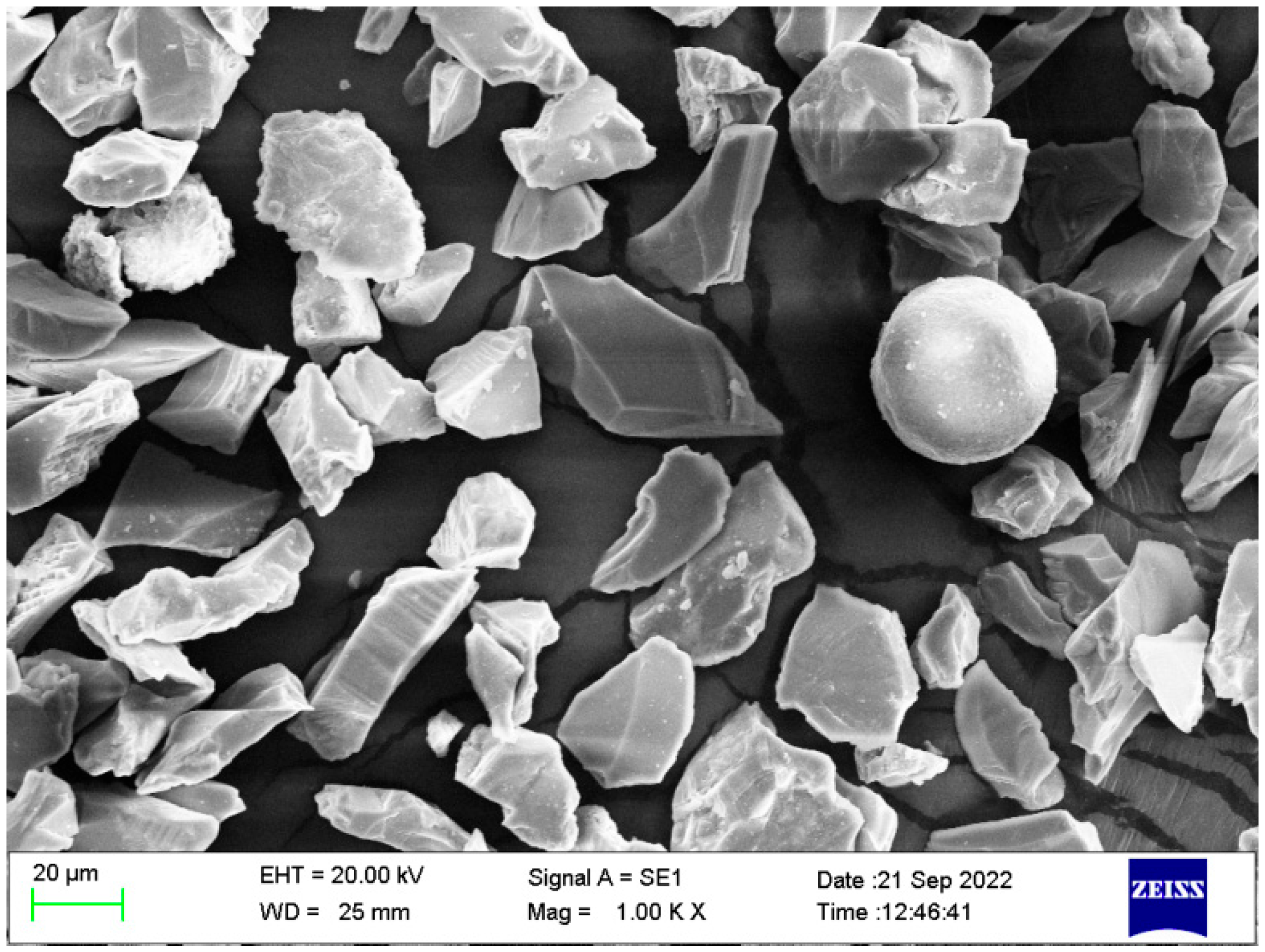
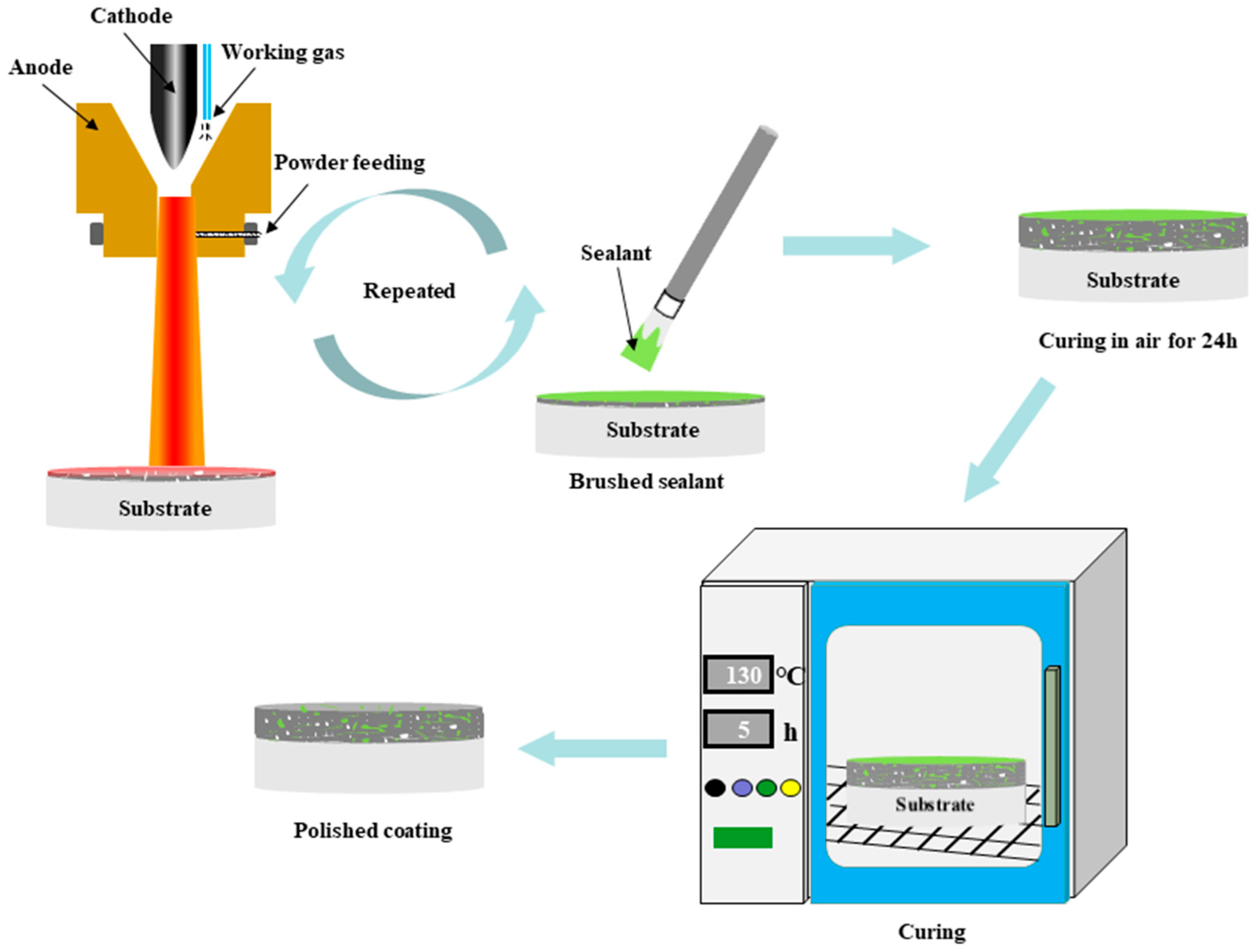

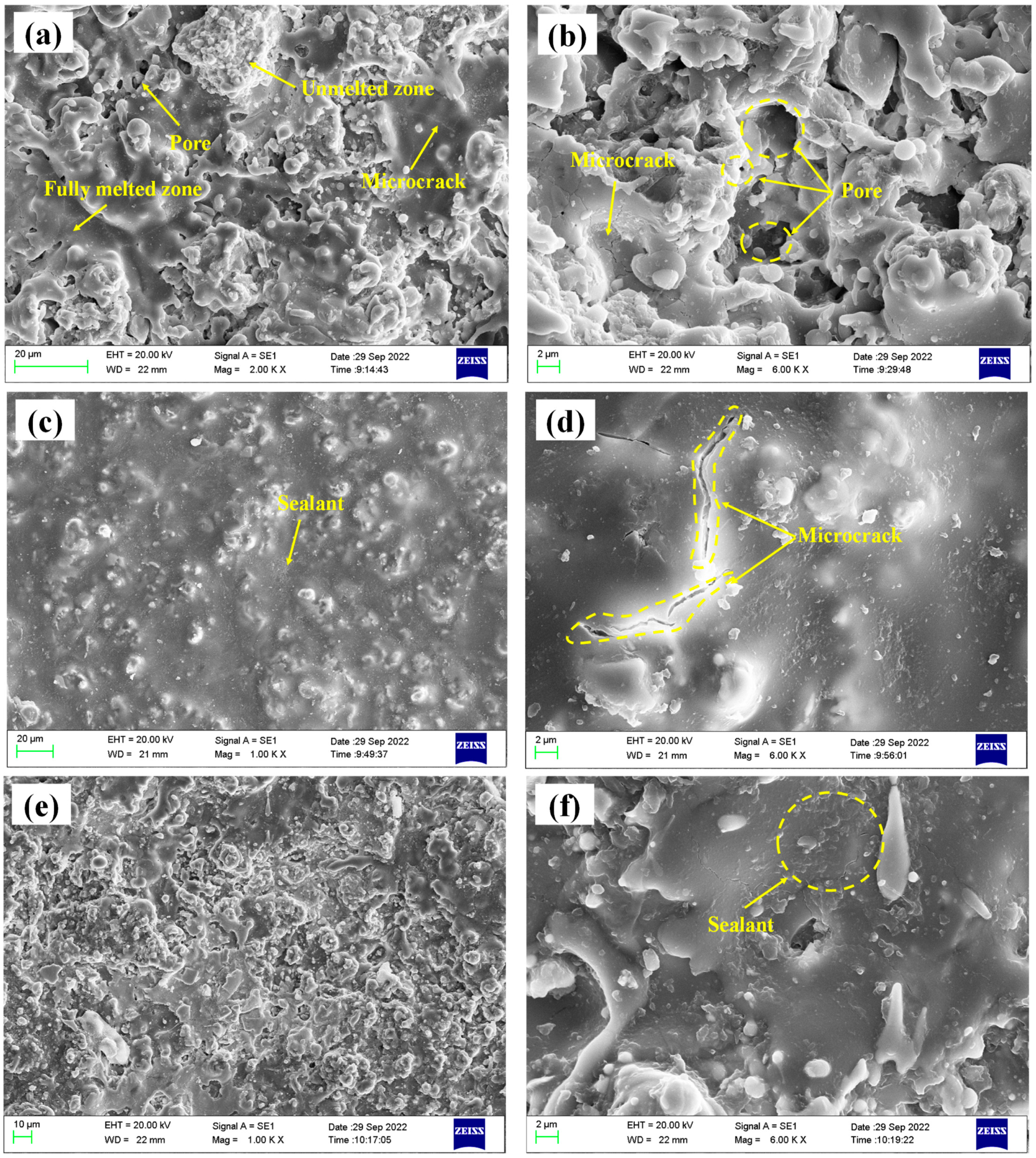
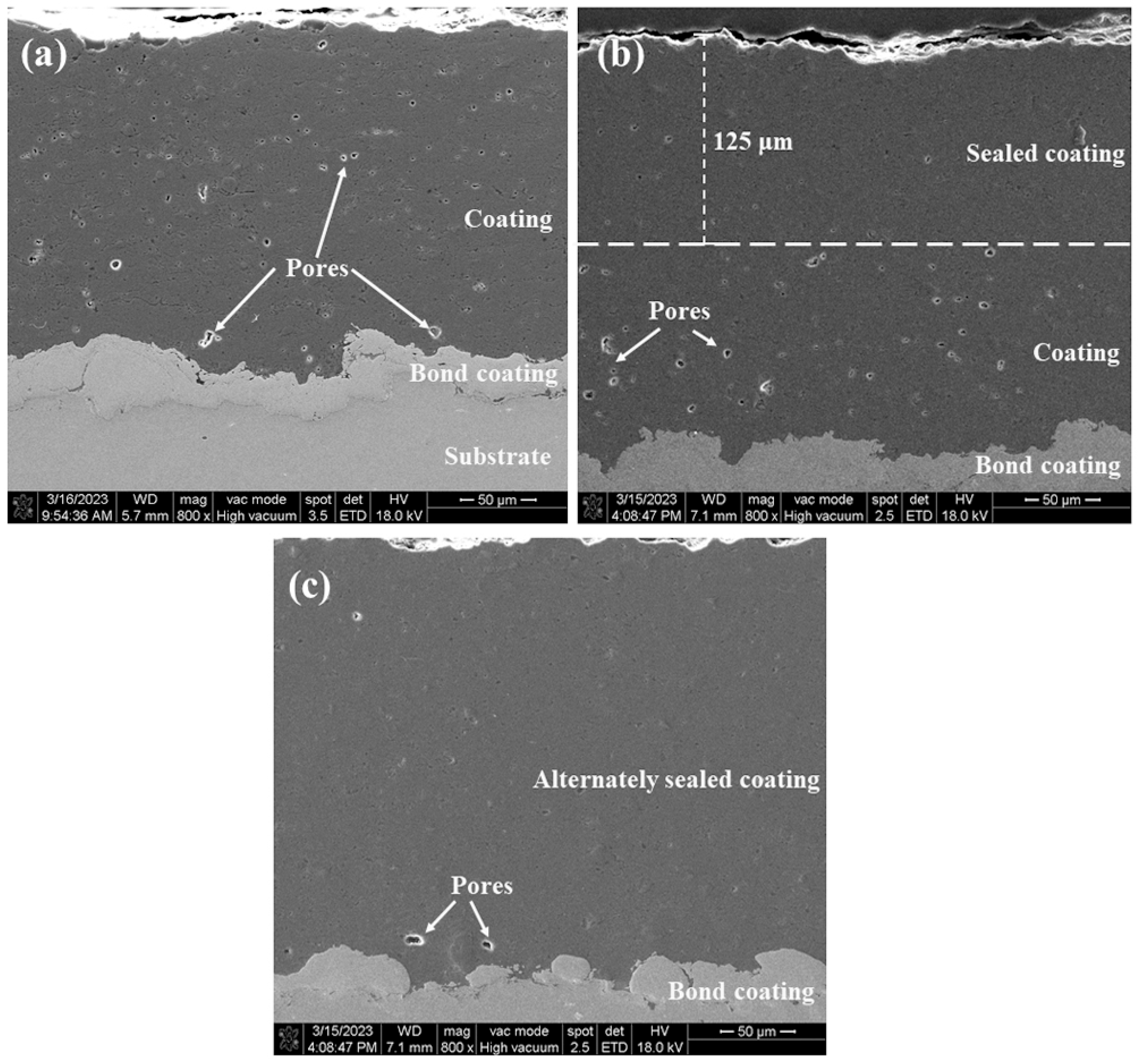

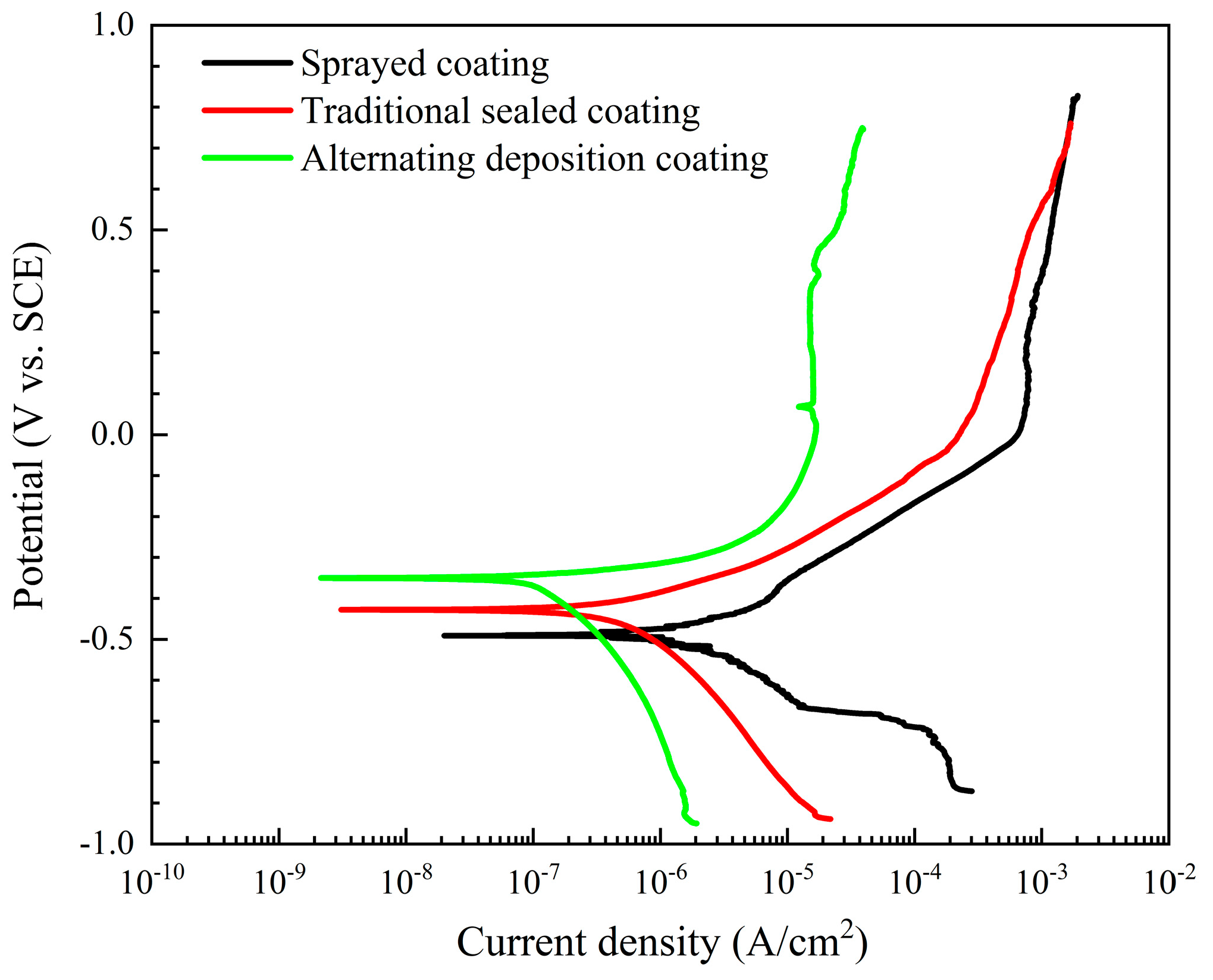



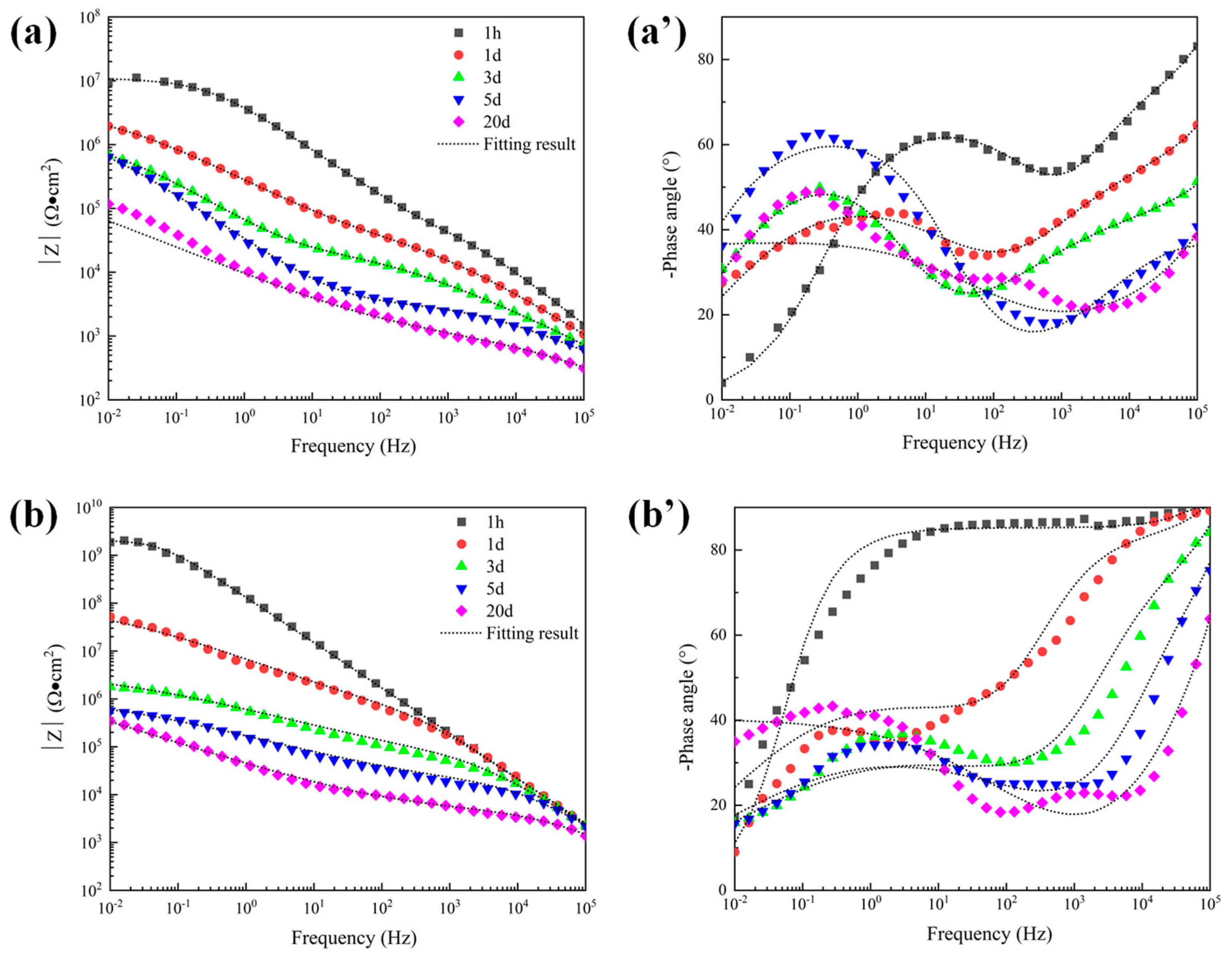

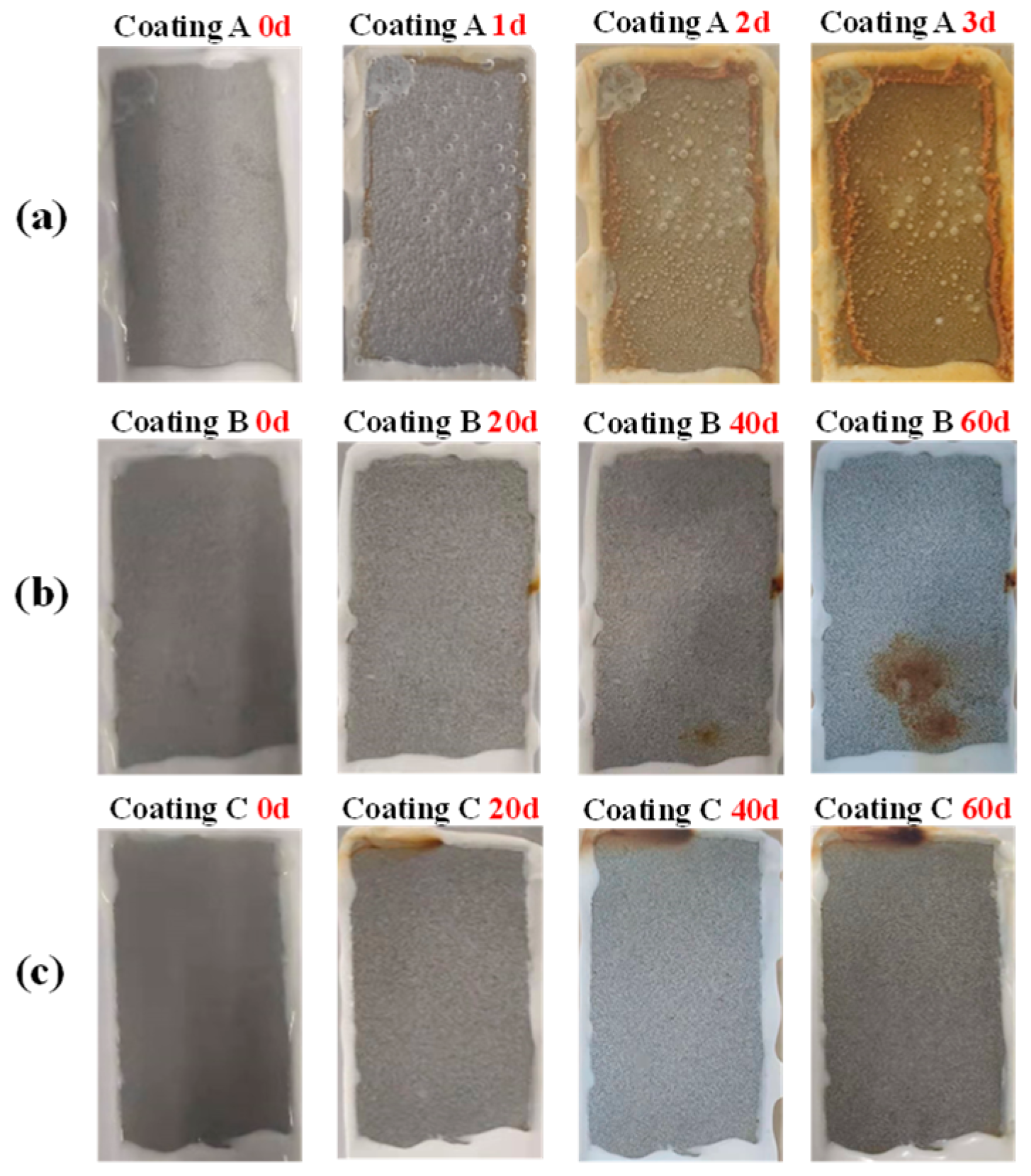
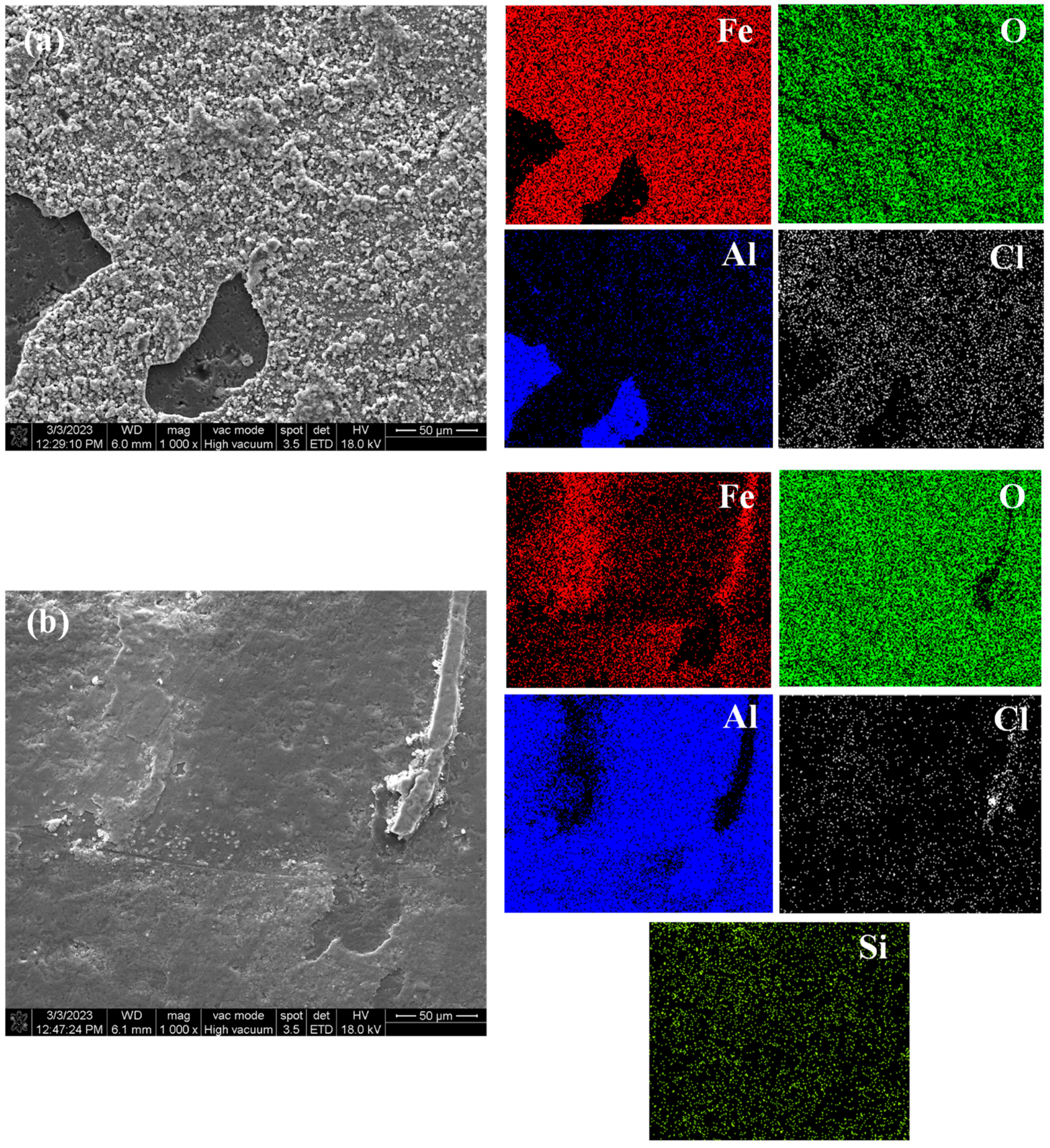
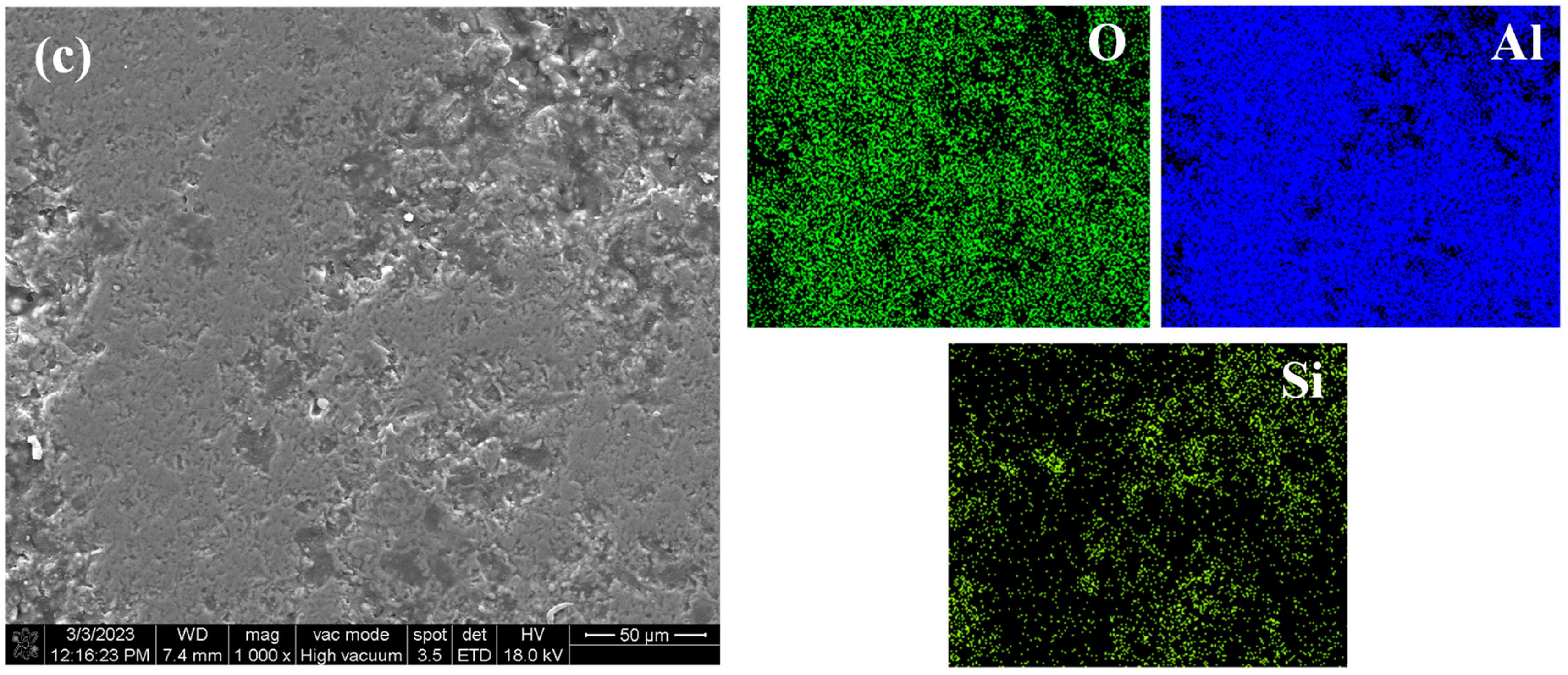
| Voltage (V) | Current (A) | Ar (L/min) | H2 (L/min) | Spraying Distance (mm) | Powder Feed Rate (g/min) | |
|---|---|---|---|---|---|---|
| NiCr | 120 | 440 | 180 | 8 | 100 | 11 |
| Al2O3 | 130 | 430 | 100 | 22 | 120 | 9.5 |
| Samples | Ecorr (mV vs. SCE) | icorr (A/cm2) | Rp (Ω·cm2) | Si (%) | Porosity (%) |
|---|---|---|---|---|---|
| spray coating | −490 | 1.8383 × 10−6 | 13054 | 2.4 | |
| traditional sealed coating | −424 | 4.6019 × 10−7 | 47210 | 75 | 1.39 |
| alternating sealing coating | −350 | 1.0400 × 10−7 | 82679 | 94.6 | 0.41 |
Disclaimer/Publisher’s Note: The statements, opinions and data contained in all publications are solely those of the individual author(s) and contributor(s) and not of MDPI and/or the editor(s). MDPI and/or the editor(s) disclaim responsibility for any injury to people or property resulting from any ideas, methods, instructions or products referred to in the content. |
© 2024 by the authors. Licensee MDPI, Basel, Switzerland. This article is an open access article distributed under the terms and conditions of the Creative Commons Attribution (CC BY) license (https://creativecommons.org/licenses/by/4.0/).
Share and Cite
Feng, Y.; Liu, M.; Jia, L.; Bai, Y.; Ma, G.; Zhou, X.; Wang, H.; Wang, H. Study on the Corrosion Resistance of Supersonic Plasma Spraying Al2O3 Thin Layer and SiO2 Sealer Alternately Deposited Coating. Coatings 2024, 14, 78. https://doi.org/10.3390/coatings14010078
Feng Y, Liu M, Jia L, Bai Y, Ma G, Zhou X, Wang H, Wang H. Study on the Corrosion Resistance of Supersonic Plasma Spraying Al2O3 Thin Layer and SiO2 Sealer Alternately Deposited Coating. Coatings. 2024; 14(1):78. https://doi.org/10.3390/coatings14010078
Chicago/Turabian StyleFeng, Yuxi, Ming Liu, Lei Jia, Yu Bai, Guozheng Ma, Xinyuan Zhou, Haidou Wang, and Haozhen Wang. 2024. "Study on the Corrosion Resistance of Supersonic Plasma Spraying Al2O3 Thin Layer and SiO2 Sealer Alternately Deposited Coating" Coatings 14, no. 1: 78. https://doi.org/10.3390/coatings14010078
APA StyleFeng, Y., Liu, M., Jia, L., Bai, Y., Ma, G., Zhou, X., Wang, H., & Wang, H. (2024). Study on the Corrosion Resistance of Supersonic Plasma Spraying Al2O3 Thin Layer and SiO2 Sealer Alternately Deposited Coating. Coatings, 14(1), 78. https://doi.org/10.3390/coatings14010078





